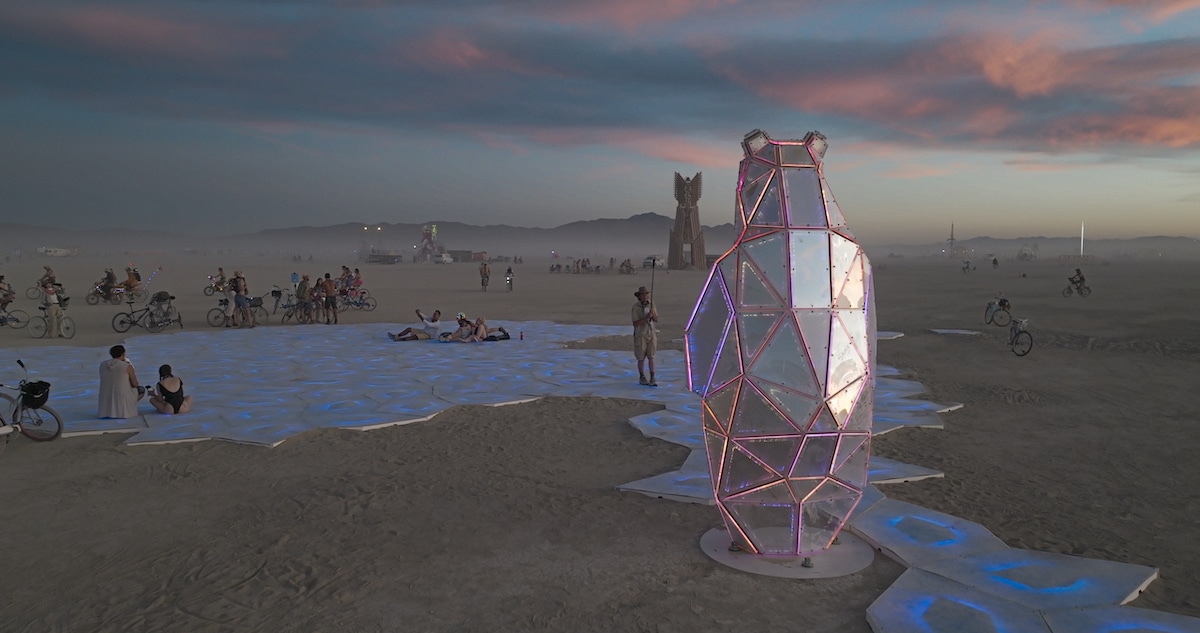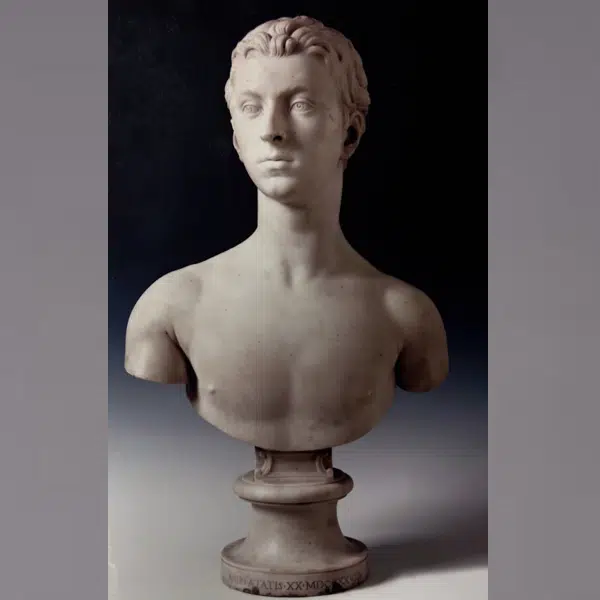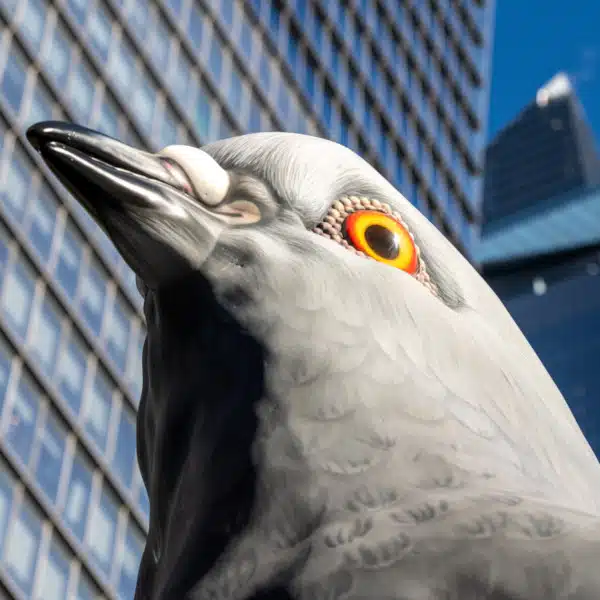
Photo: Matt Emmi / Jen Lewin Studio
After a two-year break, Burning Man came back, and with it came the innovative art installations that the festival is known for. This included an interactive LED sculpture made from recycled ocean plastic and glass by artist-engineer Jen Lewin. The Last Ocean is a large sculpture and light platform made from 10,912 pounds of recycled plastic and 9,268 pounds of glass fiber and recycled composites from coastal beach communities in South Africa.
Visitors were invited to interact with Lewin's installation, as 250 interlocking platforms of The Last Ocean illuminated over 70,000 RGB LED lights in millions of colors as people moved across the space. As users were in motion, colors swirled, catalyzing the dynamic experience of the work and representing the organic and powerful nature of the ocean. As the weekend went on, the lights in the platform began to fade, as a prompt for visitors to remember their impact on the ocean.
A bear named Ursa Minor stands at one end of the platform. Its presence is a reminder of the Arctic, which is fitting given that Lewin's installation was inspired by images of Antarctica's Ross Sea. By day, the bear's recycled materials shine bright, and by night they take on the fantastical colors of the platforms.
Luckily, The Last Ocean has a life beyond Burning Man and will be set up in several different locations. We spoke with Lewin about this, as well as the challenges of creating an installation from 100% post-consumer materials. Read on for My Modern Met's exclusive interview.
View this post on Instagram
How did you come up with the idea for the installation?
In 2012, I first conceptualized The Last Ocean sculpture after meeting John Weller and previewing his book The Last Ocean: Antarctica's Ross Sea Project: Saving the Most Pristine Ecosystem on Earth. Weller’s photos included a series of beautiful images collected from Antarctica’s Ross Sea that profoundly touched me.
The vast fractured landscape of ice left me with a sense of epic beauty and awe, but also a deep protective concern for the landscape's future. I was both inspired by the Ross Ice Shelf’s natural beauty, but also terrified by the melting and potential destruction of such an important landscape.

Photo: Matt Emmi / Jen Lewin Studio
The Last Ocean was a long time in the making. What was the most challenging part of bringing your vision to life?
It took well over 10 years for me to figure out a way to authentically create The Last Ocean in a way that felt socially conscious and authentic to the work. The most challenging part of this ended up being finding manufacturers who would fabricate with large percentages of recycled post-consumer material. Most American and European plastic fabricators do use post-consumer material, but only in very small percentages.
Few fabricators were willing to even talk to my team and me when I insisted that The Last Ocean be created from 100% post-consumer content. After two years of rejection, we finally found Ocean Plastic Technologies in Durban, South Africa, who was willing and open to taking on the project.

Photo: Matt Emmi / Jen Lewin Studio
Can you share a bit about the collaborators who helped you source your materials?
I began working with Ocean Plastic Technologies in 2021, which helped us hand source all ocean and ocean-bound plastic, hand clean and sort it, and then use it to fabricate our panels. In January 2022, Mikael Flores-Amper, lead designer and project manager at Jen Lewin Studio, and I flew to South Africa and helped directly in this process. It took several attempts to figure out the right melt temperatures, correct oven design, and correct mold shape to create our 100% post-consumer surfaces.
The vast majority of plastics used in the work include blue bottle caps (which create blue particulate swirls in the tops), clear water bottles (which make up most of the LED diffusion material), and white containers (such as milk jugs), which form the rest of the structure.

Photo: Matt Emmi / Jen Lewin Studio
How did it feel to see the installation active and working at Burning Man?
Burning Man is an exciting place to premier a work like The Last Ocean for two important reasons. First, the landscape itself is a barren, open and expansive playa, that creates an unusual and epic canvas or backdrop for a work of this scale. I have few opportunities to install work of full scale in an open landscape.
Second, the participants at Burning Man have a high level of open and expected engagement—few guests “tiptoe” around. The sculpture is truly “played with,” often in unexpected ways. My team and I have watched as participants dance on the work, picnic on the work, sit and watch the work, do yoga on the work, play tag on the work, do handstands on the work, take naps on the work, kiss loved ones on the work, etc. We are often surprised, excited, and possibly even inspired by how participants at Burning Man engage with their environment.

Photo: Matt Emmi / Jen Lewin Studio
Why do you think it's important for artists to engage in social issues as part of their creative process?
For me, “Art” and “Life” are entirely intertwined. There is no edge condition where my experience as a human on this planet differs from my experience conceptualizing and building art. My life is filled with social engagement; community and society are reliant on our living environment. My artwork follows—it is engaged in our society and community, and it is reliant on our planet and environment.

Photo: Matt Emmi / Jen Lewin Studio
What do you hope that people take away when they experience the installation?
There are many different ways to think about climate change, precious resources (like the Ross Ice Shelf), or planetary problems like existing plastic waste. When it comes to plastic waste, while ultimately, I believe that humans need to put an end to the appalling levels of single- or limited-use plastic production, in the interim, we will also need a solution for the hundreds of thousands of tons of plastic already in the ocean.
I hope that transforming my practice to more closely engage and pay attention to the preciousness of our planet can help set an example for other artists, fabricators, and the like. I am not promising a solution but pushing to activate engagement, awareness, and open communication that I hope can lead to solution finding and a better future.

Photo: Matt Emmi / Jen Lewin Studio
What are the plans for the installation now that Burning Man is over?
The installation will be traveling to downtown Detroit, then to Arizona, and on to the Exploratorium in San Francisco in November.






















































































